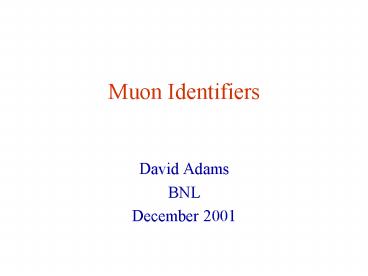Muon Identifiers
1 / 16
Title: Muon Identifiers
1
Muon Identifiers
- David Adams
- BNL
- December 2001
2
Contents
- Definitions
- Use cases
- Requirements
- Design issues
- Implementation
- Status
- Future
3
Definitions
- Identifier
- Label used to identify a piece of the detector
- Technology
- Muon has four MDT, CSC, RPC and TGC
- Channel
- Independently read out piece of the detector
- Station
- Geographical region of the muon detector
- BIL, BOS,
4
Definitions (cont)
- Module
- Collection of channels of the same technology
organized into a mechanical structure - At each station there is at most one module for
each technology
5
Use cases
- 1. Label
- We want an association between digits (signals
read from the detector) and the channel - Create an identifier for each channel
- Include the appropriate channel identifier as
part of the digit
6
Use cases (cont)
- 2. Navigating the hierarchy
- The detector description is hierarchical
- Use the identifiers to navigate the hierarchy
- Each identifier provides a mean to access its
parent, children and siblings
7
Use cases (cont)
- 3. Muon digit container
- Muon digit container can be used as follows
- Create an identifier for a technology, e.g. MDT
- The technology ID is used to fetch the associated
list of module identifiers - The module ID is used as a key to fetch the
digits associated with that module - Each digit is queried for its channel ID
- The channel ID is then used as a key to access
calibration or alignment information
8
Requirements
- 1. Identifiers follow detector description
- Provide identities for
- Muon system
- Technologies
- Modules
- Channels
- Match the detector hierarchy
- 2. Consistent with ATLAS ID scheme
- ATL-SOFT-2001-004
- Ed S. Goldfarb and A. Schaffer
9
Requirements (cont)
- 3. Identifiers carry the actual structure
- Impossible to construct non-physical identifiers
- 4. Identifiers have an ordering mechanism
- So identifiers can be used as keys in associative
containers (e.g. maps) - 5. Mechanism for navigating the hierarchy
- Up (from channel to its module)
- Down (from module to its list of channels)
- Neighbor (to adjacent element) not needed
10
Requirements (cont)
- 6. Connection to ATLAS Identifier class
- Identifiers must convert to and from standard
ATLAS Identifier objects - Allows access to calibration and geometry
databases - Provides index required for persistent references
to detector elements
11
Design Issues
- 1. Avoiding cyclic dependencies.
- Identifiers know about their parents but not
their children - Channels know their module
- Modules do not know their channels
- Child class (or some other higher level class or
function) constructs the corresponding list of
child IDs from the parent ID
12
Design issues (cont)
- 2. Atlas-specific constraints
- Connection with Identifier class
- Require conversion to and from ATLAS Identifier
- Where to obtain muon structure
- Use the external identifier dictionary when it is
available - For now an approximate description is fixed
- Do we need Ma/Meesen hash conversion?
- If so we can use the conversion to the ATLAS
Identifier class
13
Design issues (cont)
- 3. Fetching detector attributes
- Alignment and calibration information pertinent
to a particular detector element is not obtained
directly from the corresponding identifier - The identifier is used as a key to access the
appropriate database - 4. Identifiers carry the detector structure
- Separate class for each level
- Numbers of and associations between identifiers
specified by identifier dictionary
14
Design Issues (cont)
- 5. Identifier validity
- Do not throw exception or crash if user attempts
to construct an invalid identity - Instead identifiers can be in an invalid state
- This allows default identifiers required for C
containers
15
Status
- Current implementation
- All classes in package MuonSpectrometer/MuonIdenti
fiers - MuonStationName (enum)
- MuonTechnology (enum)
- MuonStructure (will use the identifier
dictionary) - MuonStationId
- MuonModuleId
- MuonChannelId
- Each class has a component test
- Built and tested successfully in 2.3.0
16
Future
- 1. Read structure from identifier dictionary
- Dictionary not yet available
- 2. Add classes for the other technologies
- As needed for muon digit container or elsewhere
- 3. Add conversions to and from ATLAS Identifier
objects - The ATLAS identifiers need to be modified for the
new identification scheme































